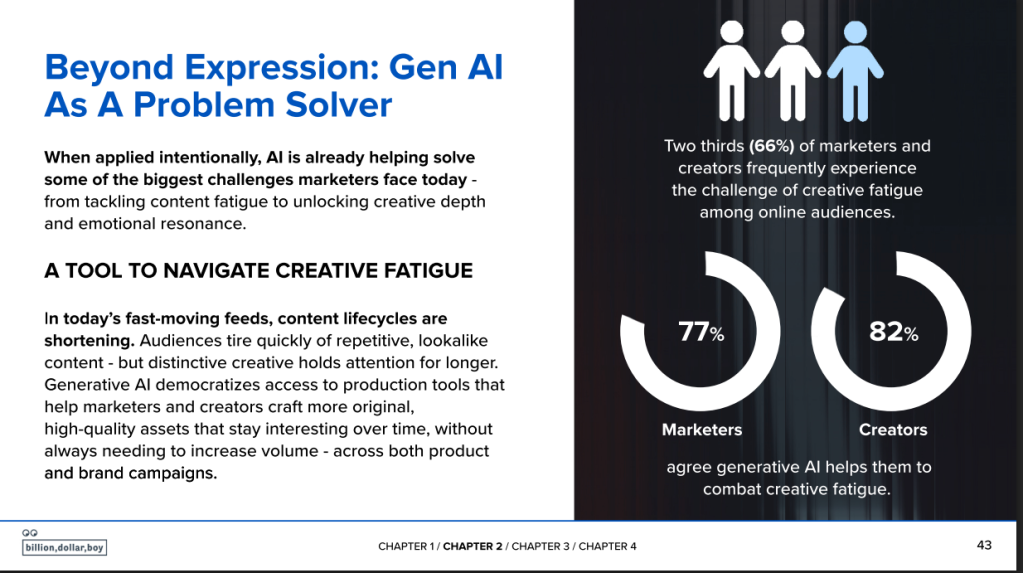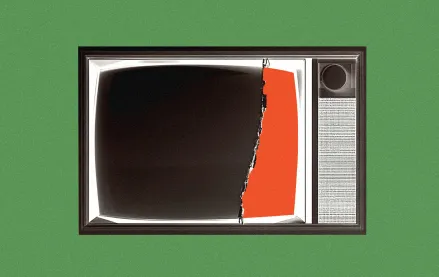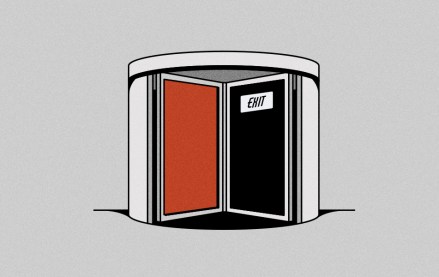In Graphic Detail: Inside the growing rift between AI efficiency and audience trust

The debate over AI slop has had a dizzying run over the last week or so.
Disney kicked things off by announcing that Disney+ subscribers will soon be able to spin up their own content using its characters. A former video game studio head chimed in to note that younger audiences are already using this stuff. And TikTok added more fuel by confirming its testing controls that lets users adjust the amount of AI-generated material in their feeds — an update that landed alongside the revelation that more than 1.3 billion videos on the platform now carry an AI label.
All of it points to an entertainment pipeline being retooled in real time, where the separation between craft and machine output grows a little more porous each week.
Here are five charts that ground where the debate stands as the year winds down:
First up: marketers and consumers are enthusiastic about generative AI
Recent data from Kantar captures the mood. Nearly two-thirds of consumers (68%), feel positive about the possibilities of generative AI, and marketers are even more bullish with 75% expressing optimism. The findings come from two separate surveys: one of 21,3000 people across 30 markets with at least 500 respondents in each, conducted between May and August 2025. The other of 974 senior marketers globally.
Even with that level of enthusiasm, marketers are striking a note of caution. More AI-generated content means more uncertainty over what is authentic and what is engineered. Platforms built their empires on user-generated material that rewarded passive consumption, enabled new realities and helped fragment audiences. AI accelerates that dynamic, tightening the feedback loop and amplifying the stakes.

Trust concerns around generative AI are also colliding with a broader sense that the tech is being pushed onto people rather than adopted on their terms
No one is under illusions that society is drifting toward a future saturated with AI-generated content. Marketers, more than most, will ensure the shift takes hold. The incentives are clear: faster, cheaper output that scales. Or rather they’re clear enough to overshadow the risk that generative AI does not necessarily improve creative work, and it makes the core job of advertising — sparking a positive reaction — more difficult when audiences already feel the tech is being pushed onto them. In the U.K. and U.S., more than two-thirds of generative AI distrusters say the tech feels forced, according to Edelman, which surveyed over 1,000 respondents in each market.
The result is a widening tension between the efficiencies marketers want and the discomfort people are signaling in return.

AI can produce more ads, but brands still need guardrails
If the latest flare-up over AI slop made anything clear, it is that brands cannot treat volume as a proxy for quality. Coca-Cola’s Christmas AI campaign — now an annual Rorschach test for AI-generated advertising — offers the latest case study. Viewers quickly flagged the telltale glitches: shape shifting trucks, continuity errors and uncanny animals.
Executives, for their part, recognize the limits of a laissez-faire approach. A recent study from Bynder of 1,800 business leaders found that nine in 10 believe human oversight remains essential when using AI to protect brand identity and maintain compliance. Understandably, those concerns aggregated around governance (see chart). Speed and cost savings may be winning over CFOs, but brands still need real guardrails if they want AI-generated work to resonate rather than appeal.
“Marketers need to rethink how they use gen AI in advertising,” said Jim McGorty, creative director at brand experience agency onepointfive. “Missteps don’t just weaken creative — they expose cultural blind spots and erode brand trust. And in a world where audiences already assume their feeds are distorted, that skepticism is only accelerating.”

For better or worse, AI-made ads are a talking point
And they will remain one because the industry is now living in the gap between what AI makes possible and what audiences are willing to accept.
Coca-Cola’s festive campaign is a case study in that dynamic. It generated 38,752 messages and more than 735,000 engagements across X, Reddit and Facebook between Oct. 8 and Nov. 18, according to Sprout Social. That made it the most talked about holiday campaign on social media — outpacing John Lewis, Marks and Spencer, and Lidl U.K.
The volume did not translate to uniformly positive reaction, Nearly two-thirds of sentiment was positive but a sizable share of the conversation focused on the ad’s glitches and AI tells. The campaign landed but it also surfaced the industry’s ongoing tension: AI can drive attention yet it alone doesn’t revolve whether the work connects in the way brands intend.
“There is absolutely no need, or in this case excuse, for shape shifting trucks or uncanny animals,” said Jon Williams, CEO of creative network The Liberty Guild. “That’s so last year. From a brand with their marketing muscle, and indeed from a brand that helped to define the color scheme for Christmas way back in 1931 this doesn’t have their usual meticulous craft. Real people don’t care if it’s AI or not. That’s our own special little industry hang up.”
What they care about, he continued, is that it has an idea in it — that’s the most important thing “you need to differentiate your brand from the slop” he added.

What the data reveals about AI and creative expectations
Two thirds of marketers and creators say generative AI helps them get past creative blocks, according to Billion Dollar Boy, which surveyed 1,000 marketers and 1,000 creators over the summer.
Useful as that is, it also feeds into a broader shift in viewing habits. AI has stripped away many barriers to making content, not necessarily good content, but content that is passable enough to hold attention. As that output scales, the risk grows that audiences acclimate to a steady stream of “good enough” material, reshaping expectations in ways the industry isn’t fully prepared for.
Useful as that is, it also feeds into a broader shift in viewing habits. AI has stripped away many of the barriers to making content — not necessarily good content, but content that is passable enough to hold attention. As that output scales, the risk grows that audiences acclimate to a steady stream of “good enough” material, reshaping expectations in ways the industry isn’t fully prepared for.

More in Marketing

Pitch deck: How Amazon is recasting Twitch as a core part of its CTV pitch
Amazon is positioning Twitch as a defining asset in its CTV ambitions.

Netflix transforms former mall department stores into experiential venues
The location in Dallas opens this week, and one at the King of Prussia mall near Philadelphia opened last month.

Future of Marketing Briefing: AI has created a new talent paradox in programmatic agencies
The job isn’t execution anymore. AI handles that. The job is judgement.







